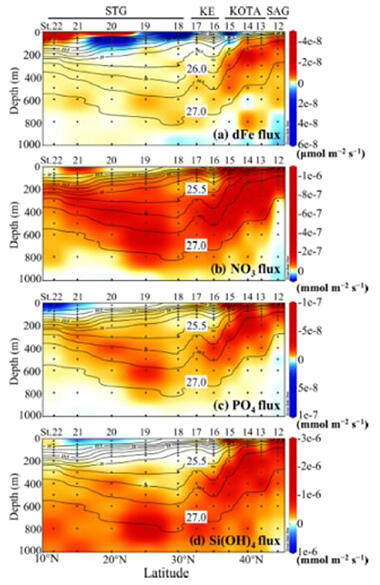A research group led by Professor Jun Nishioka of the Pan-Okhotsk Research Center, Institute of Low Temperature Science at Hokkaido University, Professor Koji Suzuki of the Graduate School of Environmental Science at Hokkaido University, and Professor Hiroshi Ogawa and Professor Ichiro Yasuda (at the time of research) of the Atmosphere and Ocean Research Institute at the University of Tokyo has revealed that the amount and stoichiometric ratios of nutrients such as iron, silicon, and nitrogen supplied from intermediate waters in the North Pacific control the phytoplankton community structure in surface layers. The findings are expected to contribute to understanding changes in marine resources and ocean carbon cycling caused by climate change. Their results were published in the international academic journal Biogeosciences on March 19.

Provided by Hokkaido University
The western North Pacific, which borders Japan, accounts for only 6% of the total ocean area but produces 27% of the world's marine resources, making it the most productive region globally.
These marine resources are supported by phytoplankton, which are primary producers, with diatom growth being particularly important. The mechanism by which photosynthesis converts CO2 into organic matter and transports it to the ocean's mid-depths through sinking is called the "biological pump," which helps maintain marine resources.
Diatoms require silicon (Si) for growth, and they have a higher iron (Fe) requirement compared to other algae. For diatoms to dominate in the ocean, silicon and iron need to be supplied to the ocean surface layer in higher ratios (chemical properties) relative to nitrates (N) and phosphates (P).
The western North Pacific subarctic east of Japan's Sanriku coast has significant nutrient and CO2 depletion from spring to autumn, with high annual organic matter production. This is attributed to continuous diatom growth from spring to summer. However, the mechanisms controlling this diatom growth remained unclear.
In this study, the research group quantitatively estimated the amount of nutrients such as Si and Fe supplied from the North Pacific Intermediate Water to surface layer water using ship observation data and compared it with phytoplankton community composition data.
Based on chemical datasets of nutrients obtained along 155°E in summer and observational data of turbulent mixing parameters observed simultaneously, they estimated the vertical fluxes of Fe, Si, N, and P from the North Pacific Intermediate Water to surface layer water and their flux ratios. They calculated the convergence and divergence of these nutrients from the obtained vertical fluxes.
They then compared these values with the surface and subsurface layer phytoplankton community composition evaluated based on algal pigment measurements. The results showed that diatom abundance was significantly correlated, especially with Fe and Si fluxes, and Fe/N and Fe/Si flux ratios.
It was found that the actual diatom amount in the western North Pacific during summer is controlled by the fluxes of Fe and Si supplied from the North Pacific Intermediate Water to the surface layer and their stoichiometric ratios.
From the calculations of nutrient convergence and divergence, it was shown that Fe and Si are supplied from the North Pacific Intermediate Water in the subarctic gyre and Kuroshio-Oyashio transition area, generating diatoms in the surface layer.
Nishioka commented, "We were able to understand part of the system where iron and nutrients spreading through intermediate layers from areas such as the Sea of Okhotsk and the Bering Sea are fertilizing the North Pacific. We believe this will be important knowledge for understanding how changes in the ocean due to climate change will affect fishery resources and carbon dioxide absorption in waters around Japan."
Journal Information
Publication: Biogeosciences
Title: Phytoplankton community structure in relation to iron and macronutrient fluxes from subsurface waters in the western North Pacific during summer
DOI: 10.5194/bg-22-1495-2025
This article has been translated by JST with permission from The Science News Ltd. (https://sci-news.co.jp/). Unauthorized reproduction of the article and photographs is prohibited.




